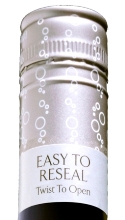By James Atkinson
About 18 million bottles of Champagne are wasted each year due to cork taint, according to a top wine critic, who has welcomed Australian winemaker De Bortoli's pioneering move to release the world's first screw-capped sparkling wines.
Wine writer Tyson Stelzer told journalists at this week's launch of the new De Bortoli wines that about five to six per cent of the Champagnes he tastes are "corked or distinctly 'corky'".
"Comparing that with other international Champagne writers there seems to be fair agreement that it's somewhere between four and six per cent," he said.
"If you do the maths somehow, Champagne ships 320 million bottles a year and that equates to 18 million bottles down the drain."
"At what cost? I reckon it must be at least a billion dollars, possibly $2 billion in corked or cork-tainted Champagne."
Stelzer said it was a gutsy move by De Bortoli to be the first to introduce the new Viiva closure, which uses technology that was five years in the making by Guala Closures.
"There's probably no more challenging sector of the wine market to pitch an alternative closure than sparkling wines," he said.
"Whether we like it or not, the consumer attachment to the pop of the cork is something that I don't think we should underestimate."
De Bortoli Wines national sales manager, Peter Yeoman added that corked sparkling has hidden cost impacts for winemakers, because consumers who have a bad experience with a brand may not go back to it.
"People turn around and they think there's an issue with the product itself, when it's actually been the closure," he said.


Where is the romance in “un-screwing” a cap on champagne?
Pretty sure DeBortoli aren’t the first to be using screw caps on sparkling wine (careful of the use of the word champagne as unless its from the region it can’t be called that) . Yellowglen and Jacobs Creek have been screw capping piccolo 200ml sparkling for some time now. Please correct me if there is a difference to how those other companies closure their wines compared to Trevi from DeBortoli?
There’s a wonderful producer in Ontario, Canada, called Flat Rock Cellars, who uses crown caps for their sparkling wine. It’s a great idea because, after all, it’s what closes the bottles during the second fermentation and aging process in the bottle prior to disgorgement.
Sparkling wine producers can have both the pop and avoid TCA and other anisole taints by putting Oeneo agglo corks in their bottles. Prior to being formed into stoppers, the cork granules are treated to a super-critical CO2 extraction that removes taints. We have tested upwards of a thousand Oeneo corks without finding any TCA.
Where is the science to backup Stelzer’s claim! I wonder if he has EVER had any of his ‘corked’ bottles tested to learn what the real problem was with the bottle. There are a ton of things that can make any wine taste off, but of course the cork always gets the blame.
Mr. Stelzer’s statement that 5-6% of all Champagnes are tainted by cork, should be considered an opinion and in no way factual. Suggesting that there’s “fair agreement” among wine writers is not scientific or quantifiable. Until figures from the wineries themselves are presented showing these percentages, the “accepted†numbers are no more real than the Yeti and are a disservice to consumers and the cork industry.
Best,
Patrick Spencer
Cork Forest Conservation Alliance
501c3 nonprofit
Apologies to Mr. Stelzer, but rigorous studies — as opposed to anecdotal evidence — show the rate of TCA at about 1%. (see http://www.corktaint.com) Steven Spurrier just wrote in Decanter that TCA is well under 1%.
Hasn’t the Australian wine industry suffered enough from artificial wine closures? The fact remains that most wine consumers still prefer natural cork. Especially on a bottle of bubbly!
Funny how the rest of the wine making world doesn’t seem to have the same problems with cork De Bortli wine makers and other who think screw caps are king do
Sarah and Jim, you raise good points regarding other closures for sparkling wines. It is certainly encouraging to see a movement in Champagne toward DIAM (Mytik) closures, particularly among grower producers, and provided these are the genuine article from Oeneo Bouchage, they do certainly appear to eliminate cork taint. Not so for some copycat brands, as Gilles Dumangin (Champagne J. Dumangin) discovered the hard way last year with cork taint under a closure he thought to be DIAM. In The Champagne Guide 2012-2013 I explain, “DIAM is a significant improvement on natural cork and the only cork product successful in eliminating cork taint. In comparative tastings with still wines, I’ve consistently noted a slight muting effect of DIAM on the aromatics of the bouquet and palate, but not nearly as acute as that of natural cork.†DIAM is not perfect, but right now, it seems that DIAM and crown seal are the most reliable closures for bottle fermented sparkling wines. Cheers, Tyson.